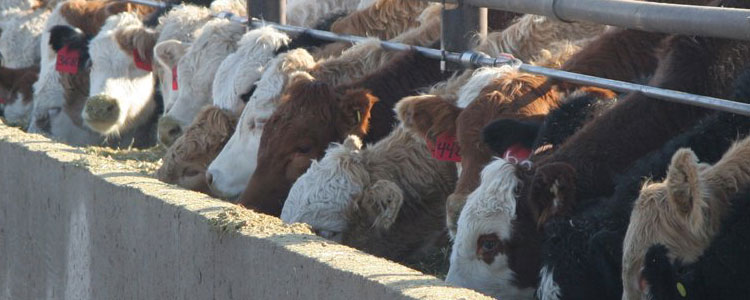
Feed Options for Holding Feedlot Cattle Gains
By Murray Feist, M.Sc., P.Ag., Provincial Livestock Specialist, Livestock Branch

Placement of finished feedlot cattle to the packing industry has been significantly reduced by the impact of COVID-19.
While simple in concept, there are many considerations to account for when implementing a maintenance ration for feedlot cattle.
- Breed: Different breeds may require different ration adjustments. Large-frame, medium-frame and dairy breeds of cattle will respond differently to changes to the diet and will reduce gains accordingly.
- Current weight and days to market.
- Desired weight gain: The ability to feed cattle to a targeted rate of gain by manipulation of diet is quite accurate. Well-formulated diets allow feedlot managers to target rate of gain and performance based on a variety of factors, including available ingredients, ingredient costs and marketing/management decisions. Any decisions on feedlot rations should come with an awareness that reducing average daily gains to a holding or maintenance level will affect final grade, dressing percentage, fat deposition and marbling composition.
- Available forage inventories. To slow the rate of gain of feedlot cattle, many rations will have to incorporate higher levels of silage, straw or hay. Often, forage inventories are close to depleted each spring, so proper ration formulation may incorporate the use of different ingredients (e.g. oat hulls) or restricted feeding measures.
Conceptually, slowing down the gains of feeder cattle involves one of two strategies: a) increase the forage percentage of the diet or b) limit feeding the cattle.
Increasing Forage Percentage of the Diet
Many feedlots utilize the most amount of feed grain and the least amount of forage in the ration to maximize energy content, rate of gain and feed:gain for finished market cattle. Typically, feedlot diets consist of 10 to 15 per cent forage and 85 to 90 per cent grain, dry matter basis, with cattle gaining 1.6 to 2.0 kg (3.5 to 4.5 lbs.) per day provided implant, ionophore and breed considerations. By increasing the forage component of the ration by seven to 10 per cent so that the ration consists of 20 to 25 per cent forage dry matter, energy density is significantly decreased and rate of gain slowed to 0.91 to 1.14 kg (2.0 to 2.5 lbs.) per day.
Further increasing the forage level in the ration will continue to decelerate daily rate of gain. While this can extend the placement time, the increase of the feed to gain and cost to gain will rise significantly while also reducing carcass yield, marble fat deposition and final grade potential.
Feedlot diets are numerous and vary depending on source ingredients. A typical western Canadian feedlot finishing diet might consist of feed barley consisting of 83 to 85 per cent barley (dry matter basis) and 10 to 15 per cent cereal silage, with the remainder being a feedlot supplement, minerals and vitamins. Cattle fed this type of ration have the potential to gain 1.6 kg (3.5 lbs.) per day.
To reduce the daily gain of a 590 kg (1,300 lbs.) feedlot steer from 1.6 to 0.91 kg (3.5 to 2.0 lbs.) per day, the ration would have to be formulated to consist of 63 per cent total digestible nutrients with silage and straw provided at 75 per cent and barley at 25 per cent dry matter. While entirely removing grain from the ration may reduce gains to an estimated 0.45 kilogram (1.0 lb.) per day, feed to gain, cost to gain, grading and marble discounts will be incurred. This option likely is not feasible to fully implement due to depleted forage inventories. Therefore, any “step down” high-forage rations that reduce feed grain by 15 to 20 per cent and average daily gains of 0.91 to 1.14 kg (2.0 to 2.5 lbs.) per day are a more realistic expectation.
The process of putting feedlot-finished cattle on a forage-based maintenance ration can occur more quickly than stepping cattle up into high-grain finishing rations. Changes from high-grain to low-grain rations can be made quite quickly with minimal risk of digestive upset. Cattle can be maintained on 100 per cent forage diets and, when applicable, start back with step-up grain finishing rations as necessary.
This is not all inclusive for options to feedlot producers when feeding feedlot cattle in the final stages of production before market. While forage availability is likely one restrictive factor dictating decisions moving forward, final market outcomes from reduced yield, grading, and daily feed and yardage expenses also are weighty considerations. Younger and lighter cattle, as well as breed and frame size, will also dictate how ration management will be decided. Producers with cattle on feed that are considering a hold or maintenance ration should consult with a nutritionist, or contact their local Ministry of Saskatchewan Livestock and Feed Extension Specialist or the Agriculture Knowledge Centre at 1-866-457-2377 to review all options.
For the latest information and for more updates on everything Kindersley ‘Like’ the Kindersley Social Facebook page below…








































